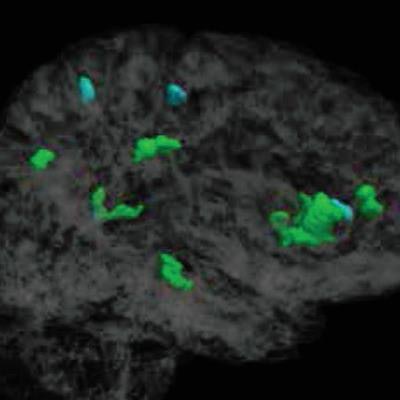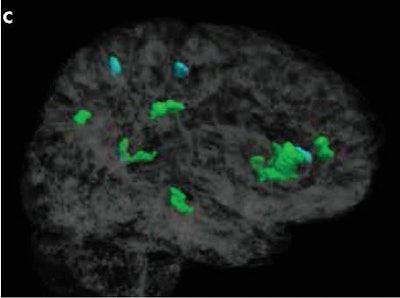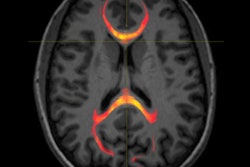
Heading a soccer ball may not always be the safest play on the pitch. Diffusion-tensor MRI (DTI-MRI) has revealed that female soccer players have more microstructural white-matter changes in brain tissue than their male counterparts, according to a study published online July 31 in Radiology.
Fractional anisotropy values, a measure of normal molecular water flow in tissue, were lower in eight brain regions in female players, compared with reduced values in three brain regions in men. That difference equated to five times the volume of white-matter tissue alterations for the female athletes.
"What is unique here is that we are actually looking at the brain tissue. We are not simply looking at symptoms that someone reports," said senior author Dr. Michael Lipton, PhD, a professor of radiology, psychiatry, and behavioral sciences, and neuroscience at Albert Einstein College in New York City. "This is a way to essentially identify that there is something at the level of brain tissue that is responding differently to a similar amount of injury in women than men."
Use your head -- or not?
Previous research has suggested that female athletes are at greater risk than male athletes for poor outcomes after acute traumatic brain injury. However, there has been some disagreement over the findings, given that many observers believe that women are more inclined to report concussion-related symptoms than men.
 Dr. Michael Lipton, PhD, from Albert Einstein College of Medicine.
Dr. Michael Lipton, PhD, from Albert Einstein College of Medicine.For more than five years, Lipton and colleagues have been investigating the effect of soccer's physicality on players through the Einstein Soccer Study. Participants are asked to report their concussion symptoms from a variety of causes, ranging from the seemingly innocuous, such as heading the ball, to collisions with other players or a goalpost.
A 2013 study by Lipton et al found that soccer players who frequently use their heads to field the ball perform poorly on memory tests and have brain abnormalities on MRI scans that are similar to those found in patients with traumatic brain injury. For the current study, they collected data on about 400 subjects, said Lipton, who also serves as the medical director of MRI at Montefiore Medical Center in New York City.
The prospective study enrolled 49 male (mean age, 25.7 years; range, 18-50 years) and 49 female (mean age, 25.8 years; range, 18-50 years) adult soccer players who were part of a larger ongoing longitudinal research into the potential adverse effects of playing the sport.
Among the inclusion criteria, subjects must have played soccer at the amateur level for more than five years and had been actively playing the sport for at least six months per year. Potential participants were excluded if they had a neurologic disorder; a mental disorder, such as schizophrenia, bipolar disorder, or psychosis; or used illicit drugs.
To make a fair comparison between the sexes, the researchers matched male and female athlete subjects on a number of factors. For example, there were no statistically significant differences between the following:
- The median numbers of headings per year (men: 487, women: 468)
- The median 12-month frequency of heading per game (10 for men and women)
- Years of playing the sport (men: 16.4 years, women 16.7 years)
"That was a specific piece of the study because, in general, men are playing more and heading the ball more than women," Lipton said. "What we specifically did was to match the players based on the amount of play and the amount of heading that they do."
One significant difference was the number of reported lifetime concussions. Male subjects had on average zero concussions (range, 0-1), while the women reported an average of one concussion (range, 0-2) (p = 0.03). However, the researchers noted that "no visible abnormalities were identified" during neuroradiological reviews of MR images of the athletes.
All 98 subjects underwent whole-brain MRI scans on a 3-tesla system (Achieva TX, Philips Healthcare) with a 32-channel head coil.
Affected regions
Based on fractional anisotropy results from DTI-MR images, the researchers observed three brain regions in male athletes where more headings were significantly associated with lower fractional anisotropy. Only in the left temporal white matter was more heading associated with significantly higher fractional anisotropy (p < 0.01 across more than 100 contiguous voxels).
For the female athletes, greater heading exposure was significantly associated with lower fractional anisotropy in eight brain regions. Increased fractional anisotropy was evident only in the left frontal white matter (p < 0.01 across more than 100 contiguous voxels). In seven of the eight brain regions, the association between heading and fractional anisotropy was stronger in women than in men.
Most important, changes in fractional anisotropy were detected across 2,121 mm3 of white matter in women, compared with 408 mm3 of white matter in men.
 DTI-MR images show how significant differences in brain regions of women (green) and men (blue) associated with heading a soccer ball and fractional anisotropy. Image courtesy of Radiology.
DTI-MR images show how significant differences in brain regions of women (green) and men (blue) associated with heading a soccer ball and fractional anisotropy. Image courtesy of Radiology."If you look at the volume of brain tissue that was affected, it was essentially five times more in women than in men," Lipton emphasized. "This [finding] builds on an idea that has been around in the medical literature that women tend to do worse following head injuries, including concussion, than men. Here we are not looking at concussion; we are looking at a much lower level of injury."
Given these findings, to what degree should soccer players, especially female athletes, change their tactics or style of play?
"We have to be cognizant that this is a preliminary finding. There is not enough information here to start making specific rules or changing what people do," Lipton said. "But I think there is more than enough information to say that there is something going on and we need to find out exactly what the connection is."
Risk vs. benefit
Referring to the 2013 study and heading's effect on memory acuity, Lipton said "some amount" of heading a soccer ball is "well-tolerated" among players. Athletes who have higher rates of heading seem to develop subtle neurological issues.
"I think the devil is in the details in figuring out at what level those effects start to become clinically significant," he added. "That is the point at which we can then potentially make recommendations that people should limit their heading to not exceed a certain amount, but that will require more research."
Along those lines, Lipton said it is likely that men and women soccer players will need to be analyzed separately, and recommendations may be needed for women that advise more conservative amounts of heading exposure.
On a more macro level, these preliminary findings are not an excuse to sit on the sidelines, he added. Participation should be weighed based on risk and benefit.
"In the context of sports and sports-related injuries, it is very important to think about the risk and the benefit. There are huge benefits in many areas -- including brain health -- to being an athlete and being active in a team-oriented sport," Lipton said. "If we tell people to stop playing and greatly diminish play, you could potentially have unintended adverse consequences. It is really a risk-benefit assessment that will require more knowledge."


.fFmgij6Hin.png?auto=compress%2Cformat&fit=crop&h=100&q=70&w=100)





.fFmgij6Hin.png?auto=compress%2Cformat&fit=crop&h=167&q=70&w=250)











